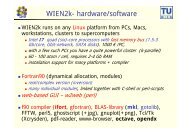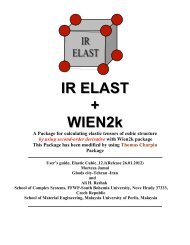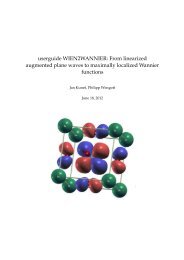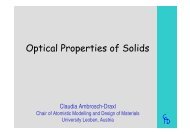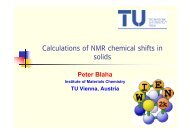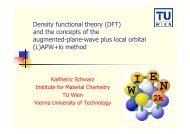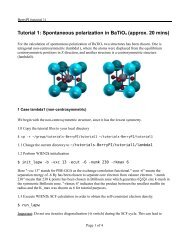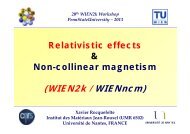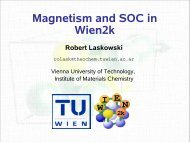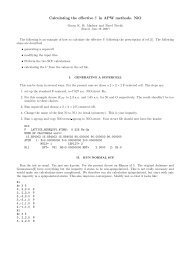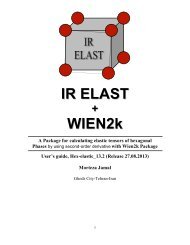Non-collinear magnetism in WIEN2k
Non-collinear magnetism in WIEN2k
Non-collinear magnetism in WIEN2k
- No tags were found...
You also want an ePaper? Increase the reach of your titles
YUMPU automatically turns print PDFs into web optimized ePapers that Google loves.
wien workshop 2003 – p.2/40
wien workshop 2003 – p.2/40
Outl<strong>in</strong>etheoretical <strong>in</strong>troduction;wien workshop 2003 – p.3/40
Outl<strong>in</strong>etheoretical <strong>in</strong>troduction;try to place implemented equations <strong>in</strong> a sequance ofapproximations beg<strong>in</strong><strong>in</strong>g from Dirac equationwien workshop 2003 – p.3/40
Outl<strong>in</strong>etheoretical <strong>in</strong>troduction;try to place implemented equations <strong>in</strong> a sequance ofapproximations beg<strong>in</strong><strong>in</strong>g from Dirac equationimportant details of implementations;wien workshop 2003 – p.3/40
Outl<strong>in</strong>etheoretical <strong>in</strong>troduction;try to place implemented equations <strong>in</strong> a sequance ofapproximations beg<strong>in</strong><strong>in</strong>g from Dirac equationimportant details of implementations;examples of calculations;wien workshop 2003 – p.3/40
Outl<strong>in</strong>etheoretical <strong>in</strong>troduction;try to place implemented equations <strong>in</strong> a sequance ofapproximations beg<strong>in</strong><strong>in</strong>g from Dirac equationimportant details of implementations;examples of calculations;how to run the code?;wien workshop 2003 – p.3/40
Dirac HamiltonianSp<strong>in</strong> as a dynamical variable is of great importance <strong>in</strong><strong>magnetism</strong>. Thus we start with Dirac Hamiltonian.H D = c⃗α · ⃗p + βmc 2 + Vwien workshop 2003 – p.4/40
¡¢ £¡¡¢ £¢ £Dirac HamiltonianH D = c ⃗α · ⃗p + βmc 2 + V⃗α is 3-component vectorof 4x4 matrixes:α k =⎛⎝ 0 σ kσ k 0⎞⎠Pauli matrixes:σ 1 =0 11 0σ 2 =0 −ii 0σ 3 =1 00 −1wien workshop 2003 – p.5/40
Dirac HamiltonianH D = c⃗α · ⃗p +β mc 2 + Vβ is 4x4 matrix: β =⎛⎝ 1 00 −1⎞⎠ 1 =⎛⎝ 1 00 1⎞⎠wien workshop 2003 – p.6/40
Dirac HamiltonianH D = c⃗α · ⃗p + βmc 2 + Vβ is 4x4 matrix: β =⎛⎝ 1 00 −1⎞⎠ 1 =⎛⎝ 1 00 1⎞⎠m - is electron mass, c - speed of the lightp - momentum operatorV - efective potential, which is related to density (DFT)wien workshop 2003 – p.6/40
Dirac equationH D = c⃗α · ⃗p + βmc 2 + V⎛H D ⎜⎝ψ 1ψ 2ψ 3⎞ ⎛= ε⎟ ⎜⎠ ⎝ψ 1ψ 2ψ 3⎞⎟⎠ψ 4ψ 4Dirac equationwien workshop 2003 – p.7/40
Dirac equationH D = c⃗α · ⃗p + βmc 2 + V⎛H D ⎜⎝ψ 1ψ 2ψ 3⎞ ⎛= ε⎟ ⎜⎠ ⎝ψ 1ψ 2ψ 3⎞⎟⎠ψ 4ψ 4Hamiltonian is 4x4 matrix operatorwave function is 4 component vectorwien workshop 2003 – p.7/40
Dirac equationH D = c⃗α · ⃗p + βmc 2 + Vlargecomponent⎛H D ⎜⎝ψ 1ψ 2ψ 3ψ 4⎞⎟⎠⎛= ε⎜⎝ψ 1ψ 2ψ 3ψ 4⎞⎟⎠smallcomponentHamiltonian is 4x4 matrix operatorwave function is 4 component vectorwien workshop 2003 – p.7/40
Dirac equationH D = c⃗α · ⃗p + βmc 2 + Vlargecomponent⎛H D ⎜⎝ψ 1ψ 2ψ 3ψ 4⎞⎟⎠⎛= ε⎜⎝ψ 1ψ 2ψ 3ψ 4⎞⎟⎠smallcomponentneglect<strong>in</strong>g contribution of small component to the charge density, onecan derive 2x2 Pauli like Hamiltonianwien workshop 2003 – p.7/40
Pauli HamiltonianH P = − 22m ∇2 + V eff + µ B ⃗σ · ⃗B eff + ζ ·(⃗σ · ⃗l)+ . . .wien workshop 2003 – p.8/40
Pauli HamiltonianH P = − 22m ∇2 + V eff + µ B ⃗σ · ⃗B eff + ζ ·(⃗σ · ⃗l)+ . . .Hamiltonian is 2x2 matrix operatorwave function is 2 component vectorwien workshop 2003 – p.8/40
Pauli HamiltonianH P = − 22m ∇2 + V eff + µ B ⃗σ · ⃗B eff + ζ ·(⃗σ · ⃗l)+ . . .Hamiltonian is 2x2 matrix operatorwave function is 2 component vector⎛ ⎞ ⎛ ⎞H P⎝ ψ 1⎠ = ε ⎝ ψ 1⎠ψ 2 ψ 2wien workshop 2003 – p.8/40
Pauli HamiltonianH P = − 22m ∇2 + V eff + µ B ⃗σ · ⃗B eff + ζ ·(⃗σ · ⃗l)+ . . .Hamiltonian is 2x2 matrix operatorwave function is 2 component vectorsp<strong>in</strong> upcomponentH P⎛⎝ ψ 1ψ 2⎞⎠ = ε⎛⎝ ψ 1ψ 2⎞⎠sp<strong>in</strong> downcomponentwien workshop 2003 – p.8/40
Pauli HamiltonianH P = − 22m ∇2 + V eff + µ B ⃗σ · ⃗ Beff + ζ ·(⃗σ · ⃗l)+ . . .effective electrostaticpotentialeffective magneticfieldsp<strong>in</strong>-(orbit)<strong>in</strong>teraction termwien workshop 2003 – p.9/40
Pauli HamiltonianH P = − 22m ∇2 + V eff + µ B ⃗σ · ⃗ Beff + ζ ·(⃗σ · ⃗l)+ . . .effective electrostaticpotentialeffective magneticfieldsp<strong>in</strong>-(orbit)<strong>in</strong>teraction termV eff = V ext + V H + V xc⃗ Beff = ⃗ B ext + ⃗ B xcwien workshop 2003 – p.9/40
Pauli HamiltonianH P = − 22m ∇2 + V eff + µ B ⃗σ · ⃗ Beff + ζ ·(⃗σ · ⃗l)+ . . .effective electrostaticpotentialeffective magneticfieldsp<strong>in</strong>-(orbit)<strong>in</strong>teraction termV eff = V ext + V H + V xc⃗ Beff = ⃗ B ext + ⃗ B xcquite important and difficult to def<strong>in</strong>e, describemany body effectswien workshop 2003 – p.9/40
Exchange potential and fieldIn DFT V xc and ⃗ B xc are def<strong>in</strong>ed by:V xc = ∂E xc (n, ⃗m), Bxc ⃗ = ∂E xc (n, ⃗m)∂n∂ ⃗mIn local density approximation (LDA):E xc (n, ⃗m) =∫nɛ xc (n, m) dr 3what results <strong>in</strong>:V xc = ɛ xc (n, m)+n ∂ɛ xc (n, m)∂n, ⃗ Bxc = n ∂ɛ xc (n, m)∂mˆmwien workshop 2003 – p.10/40
Exchange potential and fieldIn DFT V xc and ⃗ B xc are def<strong>in</strong>ed by:V xc = ∂E xc (n, ⃗m)∂nIn local density approximation (LDA):, ⃗ Bxc = ∂E xc (n, ⃗m)∂ ⃗mE xc (n, ⃗m) = nɛ xc (n, m) dr 3what results <strong>in</strong>:V xc = ɛ xc (n, m) + n ∂ɛ xc (n, m)∂n, ⃗ Bxc = n ∂ɛ xc(n,m)∂mˆmexchange field is parallel to local magnetisationdensity vectorwien workshop 2003 – p.10/40
¡¢ £<strong>Non</strong>-<strong>coll<strong>in</strong>ear</strong> caseH P = − 22m ∇2 + V eff + µ B ⃗σ · ⃗B eff + ζ ·(⃗σ · ⃗l)+ . . .If we take everyth<strong>in</strong>g, and also allow magnetisation to vary its directionfrom po<strong>in</strong>t to po<strong>in</strong>t, we will end up with 2x2 Hamiltonian:− 22m ∇2 + V eff + µ B ⃗σ · ⃗B z + . . . µ B (B x − iB y ) + . . .µ B (B x + iB y ) + . . . − 22m ∇2 + V eff − µ B ⃗σ · ⃗B z + . . .ϕ = εϕwien workshop 2003 – p.11/40
¡¢ £<strong>Non</strong>-<strong>coll<strong>in</strong>ear</strong> caseH P = − 22m ∇2 + V eff + µ B ⃗σ · ⃗B eff + ζ ·(⃗σ · ⃗l)+ . . .If we take everyth<strong>in</strong>g, and also allow magnetisation to vary its directionfrom po<strong>in</strong>t to po<strong>in</strong>t, we will end up with 2x2 Hamiltonian:− 22m ∇2 + V eff + µ B ⃗σ · ⃗B z + . . . µ B (B x − iB y ) + . . .µ B (B x + iB y ) + . . . − 22m ∇2 + V eff − µ B ⃗σ · ⃗B z + . . .ϕ = εϕsolutions are non-pure sp<strong>in</strong>ors⎛ ⎞ϕ =⎝ ψ ↑ψ ↓⎠ , ψ ↑ , ψ ↓ ≠ 0this is non-<strong>coll<strong>in</strong>ear</strong>itywien workshop 2003 – p.11/40
¡¢ £Coll<strong>in</strong>ear caseH P = − 22m ∇2 + V eff + µ B ⃗σ · ⃗B eff + ζ ·(⃗σ · ⃗l)+ . . .If we ignore only sp<strong>in</strong>-orbit term, and allow magnetisation to po<strong>in</strong>t <strong>in</strong> onedirection (z), result<strong>in</strong>g Hamiltonian will be diagonal <strong>in</strong> sp<strong>in</strong>-space.− 22m ∇2 + V eff + µ B ⃗σ · ⃗B z 00 − 22m ∇2 + V eff − µ B ⃗σ · ⃗B zϕ = εϕϕ ↑ =⎛⎝ ψ ↑0⎞⎠ , ϕ ↓ =⎛⎝ 0 ψ ↓⎞⎠solutions are pure sp<strong>in</strong>orswith non-degenerateenergiesε ↑ ≠ ε ↓<strong>coll<strong>in</strong>ear</strong> <strong>magnetism</strong>wien workshop 2003 – p.12/40
¡¢ £<strong>Non</strong>-magnetic caseH P = − 22m ∇2 + V eff + µ B ⃗σ · ⃗B eff + ζ ·(⃗σ · ⃗l)+ . . .If we ignore sp<strong>in</strong>-orbit term and magnetic exchange field, result<strong>in</strong>gHamiltonian will be diagonal <strong>in</strong> sp<strong>in</strong>-space.− 22m ∇2 + V eff 00 − 22m ∇2 + V effϕ = εϕϕ ↑ =⎛⎝ ψ 0⎞⎠ , ϕ ↓ =⎛⎝ 0 ψ⎞⎠solutions are pure sp<strong>in</strong>orswith degenerate energiesnon-magnetic solutionε ↑ = ε ↓wien workshop 2003 – p.13/40
ConsequencesImplementation of non-<strong>coll<strong>in</strong>ear</strong>ity means that we allow bothpart of the eigen-sp<strong>in</strong>or (ψ ↑ , ψ ↓ ) to be non zero at the sametime. As a result:wien workshop 2003 – p.14/40
ConsequencesImplementation of non-<strong>coll<strong>in</strong>ear</strong>ity means that we allow bothpart of the eigen-sp<strong>in</strong>or (ψ ↑ , ψ ↓ ) to be non zero at the sametime. As a result:we have to deal with 2x2 Hamiltonian, <strong>in</strong>stead of 1x1 as<strong>in</strong> <strong>coll<strong>in</strong>ear</strong> caseswien workshop 2003 – p.14/40
ConsequencesImplementation of non-<strong>coll<strong>in</strong>ear</strong>ity means that we allow bothpart of the eigen-sp<strong>in</strong>or (ψ ↑ , ψ ↓ ) to be non zero at the sametime. As a result:we have to deal with 2x2 Hamiltonian, <strong>in</strong>stead of 1x1 as<strong>in</strong> <strong>coll<strong>in</strong>ear</strong> casesthis means that diagonalisation is 4 times more expensivewien workshop 2003 – p.14/40
ConsequencesImplementation of non-<strong>coll<strong>in</strong>ear</strong>ity means that we allow bothpart of the eigen-sp<strong>in</strong>or (ψ ↑ , ψ ↓ ) to be non zero at the sametime. As a result:we have to deal with 2x2 Hamiltonian, <strong>in</strong>stead of 1x1 as<strong>in</strong> <strong>coll<strong>in</strong>ear</strong> casesthis means that diagonalisation is 4 times more expensivethis is usually much more because of los<strong>in</strong>g symmetryoperationswien workshop 2003 – p.14/40
Implementations of NCM <strong>in</strong> LAPWψ ↑ , ψ ↓ can be non-zero only when basis allows for that.wien workshop 2003 – p.15/40
Implementations of NCM <strong>in</strong> LAPWψ ↑ , ψ ↓ can be non-zero only when basis allows for that.L. Nordström and D. J. S<strong>in</strong>gh Phys. Rev. Lett. 76, 4420 (1996).pure sp<strong>in</strong>or non polarised basis, given <strong>in</strong> one global sp<strong>in</strong>coord<strong>in</strong>ate frame,basis must be supplemented by additional local orbitals,magnetisation is a cont<strong>in</strong>uous field.wien workshop 2003 – p.15/40
Implementations of NCM <strong>in</strong> LAPWPh. Kurz at al. Phys. Rev. B 63, 96401 (2001),<strong>in</strong>terstitial region and each atomic sphere have their ownquantisation axis,quantisation axis of a sphere is supposed to po<strong>in</strong>t <strong>in</strong> adirection of average magnetisation,basis functions are pure sp<strong>in</strong>or <strong>in</strong> <strong>in</strong>terstitial region,<strong>in</strong>side spheres non-pure sp<strong>in</strong>ors but polarised,atomic moment approximation (AMA).This is implemented <strong>in</strong> <strong>WIEN2k</strong>wien workshop 2003 – p.16/40
Sp<strong>in</strong> coord<strong>in</strong>ate setsα 1α2wien workshop 2003 – p.17/40
Sp<strong>in</strong> coord<strong>in</strong>ate setsα 1α2⎛⎞⎛⎞<strong>in</strong>terstices: ϕ ⃗ Gσ = ei ( ⃗ G+ ⃗ k)·⃗r χ σ , where χ σ =⎝ 1 0⎠, or⎝ 0 1⎠wien workshop 2003 – p.17/40
Basis functionsspheres - comb<strong>in</strong>ation of pure sp<strong>in</strong>ors <strong>in</strong> a local coord<strong>in</strong>ate frame:the direction of the quantisation axis is along an averagemagnetisation <strong>in</strong>side the sphere,α 1α2wien workshop 2003 – p.18/40
Basis functionsspheres - comb<strong>in</strong>ation of pure sp<strong>in</strong>ors <strong>in</strong> a local coord<strong>in</strong>ate frame:the direction of the quantisation axis is along an averagemagnetisation <strong>in</strong>side the sphere,ϕ AP W⃗Gσ(⃗k)ϕ LO⃗Gσ α == ∑ σ α ∑LGσ(A ⃗ αL(A ⃗ Gσσ αu σαlLu σαl+ B ⃗ Gσσ αL+ B ⃗ Gσσ αL˙u σαl+ C ⃗ Gσ αL)˙u σαl Y L χ σ α,)u σα2,l Y L χ σ αY L is a spherical harmonic, L stands for (l, m),χ σ α is a sp<strong>in</strong>or given <strong>in</strong> a local coord<strong>in</strong>ate frame,u, ˙u are radial function and its energy derivative.wien workshop 2003 – p.18/40
Augmentation (...)ϕ AP W⃗Gσ(⃗k)ϕ LO⃗Gσ α == ∑ σ α ∑(LA ⃗ Gσ αL(A ⃗ Gσσ αu σαlLu σαl+ B ⃗ Gσσ αL+ B ⃗ Gσσ αL˙u σαl+ C ⃗ Gσ αL)˙u σαl Y L χ σ α,)u σα2,l Y L χ σ αA L , B L , C L are calculated from sphere boundary conditions.wien workshop 2003 – p.19/40
Augmentation (...)ϕ AP W⃗Gσ(⃗k)ϕ LO⃗Gσ α == ∑ σ α ∑(LA ⃗ Gσ αL(A ⃗ Gσσ αu σαlLu σαl+ B ⃗ Gσσ αL+ B ⃗ Gσσ αL˙u σαl+ C ⃗ Gσ αL)˙u σαl Y L χ σ α,)u σα2,l Y L χ σ αA L , B L , C L are calculated from sphere boundary conditions.for APW/LAPW match<strong>in</strong>g is done to ↑ and ↓ plane waves <strong>in</strong> aglobal sp<strong>in</strong> coord<strong>in</strong>ate frame. Thus A L , B L depend on global σand local σ α sp<strong>in</strong> <strong>in</strong>dexes, and on k-po<strong>in</strong>t.wien workshop 2003 – p.19/40
Augmentation (...)ϕ AP W⃗Gσ(⃗k)ϕ LO⃗Gσ α == ∑ σ α ∑(LA ⃗ Gσ αL(A ⃗ Gσσ αu σαlLu σαl+ B ⃗ Gσσ αL+ B ⃗ Gσσ αL˙u σαl+ C ⃗ Gσ αL)˙u σαl Y L χ σ α,)u σα2,l Y L χ σ αA L , B L , C L are calculated from sphere boundary conditions.for APW/LAPW match<strong>in</strong>g is done to ↑ and ↓ plane waves <strong>in</strong> aglobal sp<strong>in</strong> coord<strong>in</strong>ate frame. Thus A L , B L depend on global σand local σ α sp<strong>in</strong> <strong>in</strong>dexes, and on k-po<strong>in</strong>t.LO has to vanish at a sphere boundary. It is a pure sp<strong>in</strong>or <strong>in</strong> alocal coord<strong>in</strong>ate frame (A L , B L , C L depend only on σ α ).wien workshop 2003 – p.19/40
Augmentation (...)ϕ AP W⃗Gσ(⃗k)ϕ LO⃗Gσ α == ∑ σ α ∑(LA ⃗ Gσ αL(A ⃗ Gσσ αu σαlLu σαl+ B ⃗ Gσσ αL+ B ⃗ Gσσ αL˙u σαl+ C ⃗ Gσ αL)˙u σαl Y L χ σ α,)u σα2,l Y L χ σ αA L , B L , C L are calculated from sphere boundary conditions.for APW/LAPW match<strong>in</strong>g is done to ↑ and ↓ plane waves <strong>in</strong> aglobal sp<strong>in</strong> coord<strong>in</strong>ate frame. Thus A L , B L depend on global σand local σ α sp<strong>in</strong> <strong>in</strong>dexes, and on k-po<strong>in</strong>t.LO has to vanish at a sphere boundary. It is a pure sp<strong>in</strong>or <strong>in</strong> alocal coord<strong>in</strong>ate frame (A L , B L , C L depend only on σ α ).for APW type of basis B = 0 <strong>in</strong> PW and LO, and additional localorbital “lo” is <strong>in</strong>troduced with C = 0, and B ≠ 0.wien workshop 2003 – p.19/40
Hamiltonian (...)In the <strong>in</strong>terstitial region we don’t have sp<strong>in</strong>-orbit,Hamiltonian is a sum of only k<strong>in</strong>etic energy and effective potentials:Ĥ = − 22m ∇2 + ˆV ,where ˆV comb<strong>in</strong>es V eff and B eff <strong>in</strong> a form of 2x2 potential matrix.wien workshop 2003 – p.20/40
Hamiltonian (...)In the <strong>in</strong>terstitial region we don’t have sp<strong>in</strong>-orbit,Hamiltonian is a sum of only k<strong>in</strong>etic energy and effective potentials:Ĥ = − 22m ∇2 + ˆV ,where ˆV comb<strong>in</strong>es V eff and B eff <strong>in</strong> a form of 2x2 potential matrix.In the spheres w can have everyth<strong>in</strong>gThus, Hamiltonian is more complicated:Ĥ = − 22m ∇2 + ˆV + Ĥ so + Ĥ orb + Ĥ cAs a result, there are same choices:wien workshop 2003 – p.20/40
Hamiltonian - spheres (...)<strong>in</strong>side sphere potential matrix: ˆV = ˆV d + ˆV off .wien workshop 2003 – p.21/40
Hamiltonian - spheres (...)<strong>in</strong>side sphere potential matrix: ˆV = ˆV d + ˆV off .AMA mode (atomic moment approximation) ˆV off is ignored.⎛ ⎞ˆV = ⎝ V ↑↑ 0⎠0 V ↓↓wien workshop 2003 – p.21/40
Hamiltonian - spheres (...)<strong>in</strong>side sphere potential matrix: ˆV = ˆV d + ˆV off .AMA mode (atomic moment approximation) ˆV off is ignored.⎛ ⎞ˆV = ⎝ V ↑↑ 0⎠0 V ↓↓FULL mode (non-<strong>coll<strong>in</strong>ear</strong>ity <strong>in</strong>side spheres)⎛ ⎞ ⎛ˆV = ⎝ V ↑↑ 0⎠ + ⎝ 0 V ↑↓0 V ↓↓ V ↓↑ 0⎞⎠wien workshop 2003 – p.21/40
¡¢ £Hamiltonian - spheres (...)SO (sp<strong>in</strong>-orbit coupl<strong>in</strong>g) -Ĥ so = ξ⃗σ · ⃗l = ξˆlzˆlx + iˆl yσ x − iˆl y−ˆl z,wien workshop 2003 – p.22/40
¡¡¢ £¢ £Hamiltonian - spheres (...)SO (sp<strong>in</strong>-orbit coupl<strong>in</strong>g) -Ĥ so = ξ⃗σ · ⃗l = ξˆlzˆlx + iˆl yσ x − iˆl y−ˆl z,ORB (lda+U) -Ĥ orb =m,m ′|m〉 v ↑ mm ′ 〈m ′ | 00 |m〉 v ↓ mm ′ 〈m ′ |,wien workshop 2003 – p.22/40
¡¡¡¢ £¢ £¢ £Hamiltonian - spheres (...)SO (sp<strong>in</strong>-orbit coupl<strong>in</strong>g) -Ĥ so = ξ⃗σ · ⃗l = ξˆlzˆlx + iˆl yσ x − iˆl y−ˆl z,ORB (lda+U) -Ĥ orb =m,m ′|m〉 v ↑ mm ′ 〈m ′ | 00 |m〉 v ↓ mm ′ 〈m ′ |,constra<strong>in</strong> field ( ⃗ B c ⊥ ẑ α ) -Ĥ c = µ B⃗ Bc · ⃗σ =0 µ B (B c,x − iB c,y )µ B (B c,x + iB c,y ) 0.wien workshop 2003 – p.22/40
¡¡¡¢ £¢ £¢ £Hamiltonian - spheres (...)SO (sp<strong>in</strong>-orbit coupl<strong>in</strong>g) -Ĥ so = ξ⃗σ · ⃗l = ξˆlzˆlx + iˆl yσ x − iˆl y−ˆl z,ORB (lda+U) -Ĥ orb =m,m ′|m〉 v ↑ mm ′ 〈m ′ | 00 |m〉 v ↓ mm ′ 〈m ′ |,constra<strong>in</strong> field ( ⃗ B c ⊥ ẑ α ) -Ĥ c = µ B⃗ Bc · ⃗σ =0 µ B (B c,x − iB c,y )µ B (B c,x + iB c,y ) 0.wien workshop 2003 – p.22/40
Allocation of the Hamiltonian and overlap matrixes (...)APW upLO upMatrix elements(<strong>in</strong>tegrals):H ⃗G, ⃗ G′ =〈 ∣ 〉 ∣∣ ψ ⃗G Ĥ∣ φ ⃗G ′ ,S ⃗G, ⃗ G′ = 〈 ψ ⃗G | φ ⃗G ′〉,APW downwhere ψ and φ can beAPW or LO, ↑ or ↓LO downwien workshop 2003 – p.23/40
Allocation of the Hamiltonian and overlap matrixes (...)APW up<strong>coll<strong>in</strong>ear</strong> setupLO upAPW downLO downwien workshop 2003 – p.23/40
Allocation of the Hamiltonian and overlap matrixes (...)<strong>coll<strong>in</strong>ear</strong> setupAPW upLO upAPW downLO downwien workshop 2003 – p.23/40
Allocation of the Hamiltonian and overlap matrixes (...)<strong>coll<strong>in</strong>ear</strong> setupAPW upLO upAPW downLO downwien workshop 2003 – p.23/40
Sp<strong>in</strong>-spiralssp<strong>in</strong>-spiral is def<strong>in</strong>ed by a vector ⃗q given <strong>in</strong> reciprocal space and anangle υ between magnetic moment and rotation axis,sp<strong>in</strong> rotation (α)lattice translation (R)⃗m n = ⃗mα = ⃗R · ⃗q( (cos ⃗q · ⃗R n) (s<strong>in</strong> υ, s<strong>in</strong> ⃗q · ⃗R n) )s<strong>in</strong> υ, cos υthe direction of the rotation axis is arbitrary.wien workshop 2003 – p.24/40
Sp<strong>in</strong>-spiralspure translations are obviously not symmetry operations of H,H(⃗r + ⃗R n) ≠ H (⃗r) ,wien workshop 2003 – p.25/40
Sp<strong>in</strong>-spiralspure translations are obviously not symmetry operations of H,H(⃗r + ⃗R n) ≠ H (⃗r) ,translations coupled with sp<strong>in</strong> space rotations T n =are symmetry operations of H;T n † H (⃗r) T n = U † ( −⃗q · ⃗R n) H(⃗r + ⃗ R n) U{−⃗q · ⃗R n |ɛ| ⃗ R n }(−⃗q · ⃗R n) ,wien workshop 2003 – p.25/40
Sp<strong>in</strong>-spiralspure translations are obviously not symmetry operations of H,H(⃗r + ⃗R n) ≠ H (⃗r) ,translations coupled with sp<strong>in</strong> space rotations T n =are symmetry operations of H;T n † H (⃗r) T n = U † ( −⃗q · ⃗R n) H(⃗r + ⃗ R n) U{−⃗q · ⃗R n |ɛ| ⃗ R n }(−⃗q · ⃗R n) ,Group of T n is Abelian, thus it has one dimensional representations,T n ψ k (r) = U (−q · R n ) ψ k (r + R n ) = e ik·Rn ψ k (r) .wien workshop 2003 – p.25/40
Sp<strong>in</strong>-spiralspure translations are obviously not symmetry operations of H,H(⃗r + ⃗R n) ≠ H (⃗r) ,translations coupled with sp<strong>in</strong> space rotations T n =are symmetry operations of H;T n † H (⃗r) T n = U † ( −⃗q · ⃗R n) H(⃗r + ⃗ R n) U{−⃗q · ⃗R n |ɛ| ⃗ R n }(−⃗q · ⃗R n) ,Group of T n is Abelian, thus it has one dimensional representations,T n ψ k (r) = U (−q · R n ) ψ k (r + R n ) = e ik·Rn ψ k (r) .Bloch theorem!!!wien workshop 2003 – p.25/40
Sp<strong>in</strong>-spiralsWave function of a spiral structure is of the form:⎛⎞ψ k (r) = e ik·r ⎝ e −iq·r2 u ↑ k (r) ⎠e iq·r2 u ↓ k (r) ,where u σ (r) has translational periodicity.wien workshop 2003 – p.26/40
Sp<strong>in</strong>-spiralsWave function of a spiral structure is of the form:⎛⎞ψ k (r) = e ik·r ⎝ e −iq·r2 u ↑ k (r) ⎠e iq·r2 u ↓ k (r) ,where u σ (r) has translational periodicity.↑ part of a sp<strong>in</strong>or transform with k − q 2, ↓ part of a sp<strong>in</strong>or transformwith k + q 2. The basis has to be composed us<strong>in</strong>g condition:∣∣G + k ± q ∣ ≤ G max ,2with “−” for ↑, and “+” for ↓. This can generate different numbers ofbasis functions for ↑ and ↓ sp<strong>in</strong>s.wien workshop 2003 – p.26/40
Intra-atomic NCM, fcc P u(a) plane x = 0 (b) plane z = 1/10Sp<strong>in</strong> density maps of fcc Pu. Calculation <strong>in</strong> FULL mode with SO. Average momenta po<strong>in</strong>t to〈001〉wien workshop 2003 – p.27/40
Intra-atomic NCM, bcc U(c) plane x = 1/2 (d) plane z = 6/10Sp<strong>in</strong> density maps of bcc U (unit cell size 9 a.u.). Calculation <strong>in</strong> FULL mode with SO.Average momenta po<strong>in</strong>t to 〈001〉wien workshop 2003 – p.28/40
γ Fe, sp<strong>in</strong> spiral0total energy [Ry]-0,001-0,002-0,003AMAFULLlocal sp<strong>in</strong> moment [µ B]1,81,71,61,51,4AMAFULL-0,004ΓqX1,3ΓqXLocal sp<strong>in</strong> moment and total energy versus sp<strong>in</strong>-spiral ⃗q vector.wien workshop 2003 – p.29/40
γ Fe, sp<strong>in</strong> spiralAMAFULLSp<strong>in</strong> density maps for q = 0.6 (0-Γ, 1-X)wien workshop 2003 – p.30/40
Magnetic structure of Mn 3 SnChemical structure of Mn 3 Snwien workshop 2003 – p.31/40
Magnetic structure of Mn 3 Snfmwien workshop 2003 – p.31/40
Magnetic structure of Mn 3 Snfmafmwien workshop 2003 – p.31/40
Magnetic structure of Mn 3 Snfm afm ncm 1wien workshop 2003 – p.31/40
Magnetic structure of Mn 3 Snfm afm ncm 1ncm 2wien workshop 2003 – p.31/40
Magnetic structure of Mn 3 Snfm afm ncm 1ncm 2 ncm 3wien workshop 2003 – p.31/40
Magnetic structure of Mn 3 Snfm afm ncm 1ncm 2 ncm 3 ncm 4wien workshop 2003 – p.31/40
Magnetic structure of Mn 3 Snso fm afm ncm 1 ncm 2 ncm 3 ncm 4E fm − E [Ry] - 0.0 0.0131 0.0444 0.0444 0.0444 0.0444+ 0.0 0.0133 0.0441 0.0439 0.0444 0.0445M s [µ B ] - 3.012 2.684 3.037 3.037 3.037 3.037+ 3.008 2.679 3.034 3.034 3.038 3.037efg on Mn - -1.657 -2.111 -0.894 -0.894 -0.894 -0.894[10 21 V/m 2 ] + -1.661 -2.119 -0.892 -0.899 -0.891 -0.894-0.898 -0.881hff on Mn - -309.9 -153.1 31.2 31.2 31.2 31.2[kGauss] + -309.6 -152.9 31.1 31.5 31.5 30.9<strong>in</strong> non-so case all ncm structures are symmetry equivalent32.2 32.1with so ncm structures become <strong>in</strong>equivalent, additionally for ncm3 and ncm4 Mn 2 andMn 5 are no longer equivalent to the rest of Mn’swien workshop 2003 – p.32/40
NCM <strong>in</strong>put filecase.<strong>in</strong>ncm:FULL0 0 060.00000 90.00000 0180.00000 90.00000 0300.00000 90.00000 060.00000 90.00000 0180.00000 90.00000 0300.00000 90.00000 00.00000 0.00000 00.00000 180.00000 00.50000wien workshop 2003 – p.33/40
NCM <strong>in</strong>put filecase.<strong>in</strong>ncm:FULL0 0 060.00000 90.00000 0180.00000 90.00000 0300.00000 90.00000 060.00000 90.00000 0180.00000 90.00000 0300.00000 90.00000 00.00000 0.00000 00.00000 180.00000 00.50000first record def<strong>in</strong>es mode of calculation(FULL/AMA)second record def<strong>in</strong>es sp<strong>in</strong>-spiralvector;next records conta<strong>in</strong> polar angles (φ, θ)def<strong>in</strong><strong>in</strong>g directions of magnetisation <strong>in</strong>each sphere and optimisation switch;last number is a mix<strong>in</strong>g parameter useddur<strong>in</strong>g calculation of the constra<strong>in</strong> field;wien workshop 2003 – p.33/40
NCM <strong>in</strong>put filecase.<strong>in</strong>ncm:FULL0 0 060.00000 90.00000 0180.00000 90.00000 0300.00000 90.00000 060.00000 90.00000 0180.00000 90.00000 0300.00000 90.00000 00.00000 0.00000 00.00000 180.00000 00.50000first record def<strong>in</strong>es mode of calculation(FULL/AMA)second record def<strong>in</strong>es sp<strong>in</strong>-spiralvector;next records conta<strong>in</strong> polar angles (φ, θ)def<strong>in</strong><strong>in</strong>g directions of magnetisation <strong>in</strong>each sphere and optimisation switch;last number is a mix<strong>in</strong>g parameter useddur<strong>in</strong>g calculation of the constra<strong>in</strong> field;case.<strong>in</strong>ncm is used <strong>in</strong> <strong>in</strong>itialisation stage, to lower chemical symmetrydue to magnetic moments;lapw1, lapw2, lapwdm use it to def<strong>in</strong>e quantisation axes for atomicspheres;wien workshop 2003 – p.33/40
How to run it?<strong>in</strong>itialisation – looks like <strong>in</strong> <strong>coll<strong>in</strong>ear</strong> code, but symmetry must be lowered because ofmagnetic momenta;x ncmsymmetrySCF cycle looks like:x lapw0 -ncm [...][ x orb -up, x orb -du ]x lapw1 -ncm [-p -orb -so ...]x lapw2 -ncm [-p ....][ x lapwdm -ncm [-p ...] ]x lcore -upx lcore -dnx mixer -ncmSCF job can be run with runncm script which is modified version of <strong>WIEN2k</strong> run scriptrunncm [-p -so -orb -cc 0.0001 ...]wien workshop 2003 – p.34/40
AcknowledgementsMany thanks to:Georg MadsenPeter BlahaKarlhe<strong>in</strong>z SchwarzThe Endwien workshop 2003 – p.35/40
¢£¢¢££¡¡Appendix - augmentation go backExpansion coefficients A ⃗ Gσσ αLand B ⃗ Gσσ αLare calculated from match<strong>in</strong>g condition:e i ( ⃗ G+ ⃗ k)⃗r χ g σ =σ α LGσσA ⃗ αL u σαl+ B ⃗ Gσσ αL˙u σαlY L χ g σ α ,where the both sp<strong>in</strong>ors are represented <strong>in</strong> a global coord<strong>in</strong>ate frame. Multiply<strong>in</strong>g both sides∗by , <strong>in</strong>tegrat<strong>in</strong>g over sp<strong>in</strong> variable, and compar<strong>in</strong>g to the <strong>coll<strong>in</strong>ear</strong> expression:χ g σ αe i ( ⃗ G+ ⃗ k)·⃗r =LGσA ⃗ αL u σαl+ B ⃗ Gσ αL˙u σαlY L .A ⃗ Gσσ αLand BGσσ ⃗ αLare given by:A ⃗ Gσσ αL =B ⃗ Gσσ αL =χ g σ αχ g σ α∗ χgσ A ⃗ Gσ αL ,∗ χgσ B ⃗ Gσ αL .wien workshop 2003 – p.36/40
§¦¡¡¤¤¦¦¡¥¡¡¤Appendix - Hamiltonian setupgo back<strong>in</strong>terstices - basis functions are plane waves: ϕ ⃗Gσ = e i ( ⃗ G+ ⃗ k)⃗·r χ σ , and matrixelements:ϕ ⃗Gσ¡¢¡£¡Ĥ¡¢¡£¡ϕ ⃗G ′ σ′= (V σσ ′Θ) ( ⃗ G− ⃗ G′ ) + δ σσ ′2m⃗G ′ + ⃗ k2Θ( ⃗ G− ⃗ G′ )where Θ is a step function, V σσ ′ are components of the potential matrix.spheres - ϕ P ⃗Gσ W = σ α φG ⃗σσ αχ α =Hamiltonian looks like:σ αL A ⃗ Gσσ αLu σαlY L χ α , setup of theϕ P W⃗Gσ |H | ϕ P W⃗G ′ σ ′=σ αLA σαL⃗G, σB σαL⃗G ′ , σ ′,A σαL⃗G, σ= A ⃗ Gσσ αL ,B σαL⃗G ′ , σ ′=GA ⃗ ′ σ ′ σ ′αL ′σ ′α L ′u σαl Y L | H σ α σ ′α | uσ′αl ′ Y L ′.wien workshop 2003 – p.37/40
¦¡¡¦¢ £Appendix - density matrixn + m zm x − i m yρ σσ ′ = 1 2 nI 2 + σ · −→ m = 1 2m x + i m yn − m z<strong>in</strong>terstices (ρ ⃗ Gσσ ′)ρ σσ ′ (⃗r) =〈σ | ψ υ 〉 ψ υ | σ ′=ρ ⃗ Gσσ ′e i ⃗ G⃗·rυ⃗Gwave function is generated <strong>in</strong> real space: ψυ σ (⃗r) =<strong>in</strong>dexes band and k-po<strong>in</strong>t.ρ σσ ′ (⃗r) =υ (ψσ υ (⃗r)) ∗ ψ σ′υ (⃗r) ,ρ σσ ′ (⃗r) is Fourier transformed <strong>in</strong>to ρ ⃗ Gσσ ′.⃗G c ⃗ Gυ e i ( ⃗ G+⃗r)⃗·r χ σ , υwien workshop 2003 – p.38/40
¡¢£Appendix - density matrixspheres (ρ L σ α σ ′α )ρ σ α σ ′α (⃗r) =υ〈σ α | ψ υ 〉 ψ υ | σ ′α=Lρ L σ α σ ′α (r) Y s L (ˆr)ρ L σ α σ ′α are calculated with the follow<strong>in</strong>g expression:ρ L σ α σ ′α =ij l ′ l ′′ υ m ′ m ′′ D iσαυL ′ D jσ′αυL ′′ GL, L ′ , L ′′u σαl ′ u σ′αl ′′ ,where D iσαυL(i stands for A, B, C) are given by:P W :D A,σαυL=σGc ⃗ Gυ A ⃗ Gσσ αLLO, lo :D A,σαυL=Gc ⃗ Gυ A ⃗ Gσ αLwien workshop 2003 – p.39/40
¡¢ £¡¢ £Appendix - potential matrix1. local real space diagonalisation:ρ L σ α σ ′αρ ⃗ Gσσ ′→ρ σ α σ ′α (⃗r)ρ σσ ′ (⃗r)→ρ ↑ (r) 00 ρ ↑ (r)→ρL ↑ , ρL ↓ρ ⃗ G↑, ρ ⃗ G↓2. generation of <strong>coll<strong>in</strong>ear</strong> potentials:ρ L ↑ , ρL ↓ρG ⃗↑, ρG ⃗ → V ↑ L,V ↓L↓VG ⃗↑, VG ⃗↓3. local de-diagonalisation of <strong>coll<strong>in</strong>ear</strong> potentials <strong>in</strong> real space:V L↑ , V L ↓V ⃗ G↑, V ⃗ G↓→V ↑ (r) 00 V ↑ (r)→V σ α σ ′α (⃗r)V σσ ′ (⃗r)→ V L σ α σ ′αV ⃗ Gσσ ′wien workshop 2003 – p.40/40



